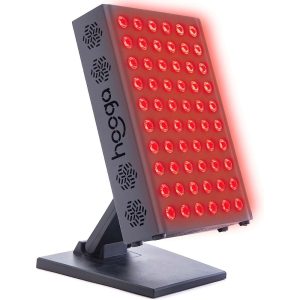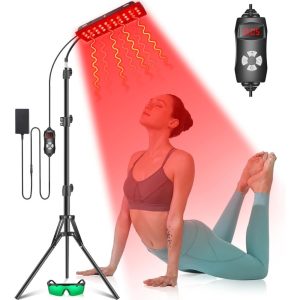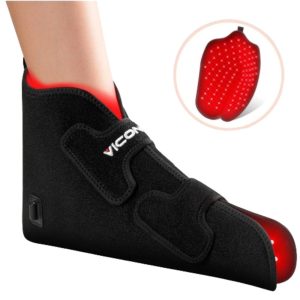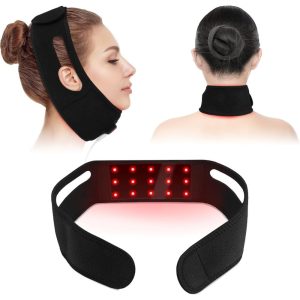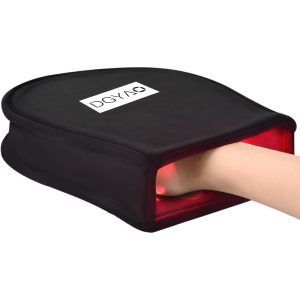Exploring the potential of red light therapy offers hope for individuals struggling with nerve pain. This innovative approach has been gaining traction as a non-invasive solution to manage and alleviate discomfort. By understanding how to apply this treatment effectively, you can unlock the key to enhancing your healing process without the reliance on pharmaceuticals.
Whether it’s the aftermath of an injury or a chronic condition like neuropathy, red light therapy could be a game-changer in your pain management routine. It’s time to dive deeper into this promising therapy’s science and practical application for nerve pain relief.
Introduction to the Science of Red Light Therapy
At the core of red light therapy lies the science of photobiomodulation. This process involves using specific wavelengths of light to trigger biological changes within the body. By illuminating affected areas with red and near-infrared light, blood vessels are encouraged to expand, enhancing circulation and promoting cellular repair.
As a pain treatment, red light therapy stands out for its ability to target tissues non-invasively. Unlike other light treatments that only affect the surface, red light penetrates deeper, reaching the muscles and nerves that are often the source of chronic pain. This depth of therapy paves the way for relief and recovery.
The Role of Red Light to Treat Neuropathy Pain
Red light therapy for nerve pain is increasingly recognized for its ability to treat neuropathy with minimal side effects. Delivering light treatments that penetrate the skin can improve circulation and reduce inflammation.
This is particularly relevant for those seeking alternatives to nonsteroidal anti-inflammatory drugs or opioids, which carry risks such as unpleasant side effects and addiction. Systematic reviews and meta-analyses have started to document the efficacy of light therapy for neuropathy, noting improvements in symptoms like burning and tingling sensations commonly associated with peripheral nerve damage.
Red Light Therapy’s Mechanisms on Cellular Health
The wavelengths of light used in treatment are specifically chosen to interact with mitochondria, leading to increased energy production and, consequently, accelerated healing. This interaction also stimulates blood vessels, which can reduce inflammation and pain. The use of red and near-infrared light in pain treatment protocols is a testament to its ability to reach deep into tissues, offering hope for long-term pain management.
Identifying Nerve Pain and Its Common Causes
Understanding nerve pain begins with the peripheral nervous system, an intricate network connecting the brain and spinal cord to all other body parts. The resulting pain can be debilitating when these nerves are damaged or dysfunctional. Identifying the symptoms early can be crucial in finding an effective treatment and preventing further damage.
Various conditions contribute to nerve pain, including diabetes, infections, traumatic injuries, and autoimmune diseases. By pinpointing the underlying causes, you can tailor your approach to managing the pain, which might include therapies like red light treatment as part of a comprehensive care plan.
6 Best Red Light Therapy Devices for Nerve Pain
When selecting a red light therapy device for nerve pain, the key factors are blood flow stimulation and light intensity. Devices that excel in these areas can significantly enhance your pain relief efforts. Let’s explore six of the best options on the market designed to address nerve pain effectively.
1. Hooga Red Light Therapy 660nm
The Hooga Red Light Therapy device utilizes the 660nm wavelength, which is optimal for skin and tissue therapy. Its design is focused on delivering targeted treatment, making it a suitable option for those looking to address specific areas of nerve pain. The device’s ease of use and efficiency make it an attractive option for home therapy.
Consistent use of the Hooga device can aid in reducing inflammation and promoting healing at a cellular level, offering a non-pharmaceutical approach to managing nerve pain. Its compact size also allows convenient treatment at home or on the go.
- Praised for its targeted treatment
- Made for portability
- Easy to use
- Efficient
- Some users may find the coverage area too limited for larger body parts
- May require multiple sessions to cover the entire affected region
2. Red Light Therapy Lamp for Body
This full-body red light therapy lamp is designed to cover larger areas, making it an excellent choice for those with widespread nerve pain. Its powerful light intensity ensures deep penetration, which can be particularly beneficial for penetrating deeper tissues where nerve pain often resides.
The lamp’s design allows easy adjustment and positioning, providing a comfortable and customizable pain treatment experience. By encompassing a broader area, this lamp can simultaneously deliver the benefits of red light therapy to multiple affected regions.
- Offers comprehensive coverage
- Has potent light intensity
- Easily adjustable
- Works simultaneously on multiple areas
- Its size may not be convenient for limited space
- Price might be higher compared to smaller, more targeted devices
3. Lifepro Red Light Therapy Belt
The Lifepro Red Light Therapy Belt offers a solution wrapped around different body parts for those seeking a hands-free approach to nerve pain management. Its flexibility ensures you can target the areas in need while continuing your daily activities.
The belt’s design incorporates red and near-infrared light, maximizing the therapeutic benefits and promoting healing within the deeper layers of tissue. This can be particularly effective for areas of the body that are otherwise challenging to treat.
- Extremely convenient to use at anytime
- Its versatility allows you to carry it around
- You can work within the light area while getting treated
- Some users may find that the belt doesn’t provide high intensity
4. Viconor Red Infrared Light Therapy for Feet
Viconor’s specialized device for feet harnesses the power of red infrared light to address neuropathy and other forms of nerve pain in the lower extremities. Its design is geared specifically towards individuals who experience foot pain, offering a tailored approach to red light therapy.
Studies, such as those published in journals like Lasers Med Sci, have shown the efficacy of red light treatment for foot conditions, reinforcing the potential of devices like Viconor’s to provide relief. Focused treatment can significantly improve comfort and mobility for those suffering from foot-related nerve pain.
- Specialized design for feet
- Highly effective for targeting foot and ankle pain
- Improves comfort and mobility
- Uses powerful and effective infrared light
- Not versatile
- May not penetrate very deep
5. LOVTRAVEL 660nm LED Red Light Therapy for Neck
LOVTRAVEL’s 660nm LED device is another targeted treatment option, focusing on the neck and upper shoulders. The 660nm wavelength is ideal for addressing the delicate tissues in these areas, where nerve pain can often manifest as a result of strain or injury.
The device’s design allows it to contour to the neck, ensuring maximum contact with the skin for optimal light absorption. This targeted approach can aid in reducing inflammation and pain in one of the most common areas for nerve-related discomfort.
- Targeted relief for hand neuropathy
- Easily contours the neck to relieve pain
- Relieves inflammation
- Portable and easy to use
- Improves blood flow and reduces discomfort
- Effectiveness can vary for best results
- Requires maximum skin contact for effectiveness
6. Red Light Therapy Device for Hands
A dedicated red light therapy device can offer non-invasive relief for those suffering from nerve pain in the hands. These devices are designed to fit comfortably over the hands, delivering therapeutic light directly to the affected areas. The convenience of a hand-specific device means that you can continue with daily tasks while receiving treatment, potentially leading to improved hand function and comfort.
The use of red light therapy for hands specifically targets the intricate network of nerves and muscles in this area. By focusing on the hands, these devices aim to stimulate cellular repair, reduce inflammation, and ultimately alleviate pain associated with conditions like carpal tunnel syndrome and arthritis.
- Enhances cellular health
- Comfortable and therapeutic
- Convenient to wear for daily tasks
- Specifically designed for hand ergonomics
- Promotes local circulation
- May not address nerve pain elsewhere
- Requires routine adherence to see benefits
Factors That Contribute to Nerve Pain Development
- Chronic diseases such as diabetes can impair blood flow, leading to nerve damage and pain.
- Physical injuries or repetitive stress can cause nerve compression or trauma, initiating pain signals.
- Lifestyle factors like smoking or excessive alcohol consumption can exacerbate nerve degeneration.
- Certain medications or treatments, such as chemotherapy, may have nerve pain as a side effect.
Infrared Light Therapy vs Red Light Therapy for Nerve Pain
Both infrared and red light therapy are touted for their potential benefits in neuropathy treatment. Lasers Med Sci suggests that while both can relieve pain, they operate at different wavelengths, affecting tissue repair and inflammation differently.
Infrared light often penetrates deeper, which may help with chronic inflammation. In contrast, red light therapy is praised for its effectiveness in surface-level issues like wound healing and improved balance. Their use in conditions such as diabetic neuropathy and carpal tunnel syndrome has shown reduced pain and improved nerve regeneration, making these therapies safe and effective for nerve health management.
Similarities and Differences in Their Pain Relief Approaches
Both red and infrared light therapy share a common goal of managing chronic pain and promoting cellular health. LED light therapy devices for neuropathy pain often combine these two spectrums to maximize their pain-relieving effects. The light therapy devices are designed to stimulate healing, leveraging LED technologies to address neuropathy pain.
However, differences emerge in how these therapies are applied. Red light therapy typically utilizes red LEDs to alleviate surface-level pain, while infrared light therapy, often delivered through low-power lasers or LEDs, reaches deeper tissues, addressing more persistent or severe pain conditions.
Benefits of Using Infrared Light on Nerve Regeneration
In cases where nerves are damaged, such as spinal cord injuries, infrared light therapy has been shown to support nerve regeneration. Its ability to penetrate deeper layers of tissue helps reach the damaged nerves, promoting healing and function restoration.
The warmth of infrared light can also boost blood circulation, which is crucial for delivering nutrients and oxygen needed for tissue repair and nerve regeneration, potentially offering a non-invasive alternative to conventional treatments.
Step-By-Step: How to Use Red Light Therapy at Home
Embarking on an at-home red light therapy regimen can be a game-changer for managing neuropathy pain. Ensuring you have the correct setup and usage can significantly improve your nerve health and overall comfort.
1. Set up Your Device for Optimal Pain Relief
Begin by selecting a space that allows you to relax comfortably during treatment. Position your LED light therapy device to target the affected area. The goal is to bathe the painful regions in red or infrared light, supporting the stimulation of healing and offering relief from neuropathy pain.
2. Determine the Right Dosage for Your Needs
The dosage of light therapy is critical for achieving desired results without overexposure. Start with shorter sessions and gradually increase as needed, observing how your body responds to the treatment. Following the manufacturer’s guidelines for light intensity and duration is essential to ensure safety and effectiveness.
3. Integrate Red Light Treatment with Existing Pain Management
Red light therapy can complement existing pain management strategies, such as medication or physical therapy. For those with diabetic peripheral neuropathy, an LED device providing red light can promote healing alongside other treatments, potentially enhancing overall effectiveness and leading to better pain management outcomes.
4. Integrate Massage and Acupuncture
Incorporating massage and acupuncture with red light therapy can synergize the benefits of each approach. Massage can increase blood flow to affected nerves, while acupuncture may promote natural pain relief, and when combined with red light, these therapies can enhance the body’s healing response.
5. The Role of Diet and Vitamins in Nerve Health
Nutrition plays a vital role in maintaining nerve health. A diet rich in anti-inflammatory foods and essential vitamins can support nerve function and repair. Combined with red light therapy, a nutritious diet can help address the root causes of neuropathy, contributing to overall nerve health.
The Scope of Red Light Therapy Beyond Neuropathy
Red light therapy’s potential extends beyond treating neuropathy. Its ability to penetrate the skin and stimulate cellular repair with minimal side effects makes it valuable in various conditions, from athletic recovery to managing arthritis pain. Unlike nonsteroidal anti-inflammatory drugs and opioids, red light therapy carries no risk of addiction. It has few unpleasant side effects, such as the burning sensation often associated with other treatments.
As research continues to reveal the full scope of red light therapy for nerve pain, it stands out as a promising option for those seeking non-invasive and drug-free alternatives for pain relief and tissue healing.
Red Light’s Role in Athletic Recovery and Arthritis Management
Athletes dealing with joint pain and muscle fatigue may find relief in red light therapy. Promoting cell regeneration and releasing nitric oxide, it assists in reducing inflammation and accelerating recovery times, allowing athletes to return to training sooner. The anti-inflammatory properties of red light therapy also show promise in managing arthritis symptoms, offering a soothing effect without the side effects associated with traditional medications.
For those with arthritis, the therapy’s ability to reduce inflammation and encourage tissue repair can improve joint mobility and reduce pain. As more controlled trials validate its effectiveness, red light therapy is poised to become a staple in the toolkits of both athletes and individuals managing chronic joint conditions.
Financial Considerations: FSA and HSA Benefits for Red Light Devices
When considering red light therapy for nerve pain, it’s crucial to understand how it aligns with your financial health plans. Many LED light therapy devices are eligible for purchase with Flexible Spending Accounts (FSA) or Health Savings Accounts (HSA), potentially offering a cost-effective way to manage pain. Be sure to check with your plan’s specifics as coverage can vary, and remember that obtaining a Letter of Medical Necessity from a healthcare provider may be required for reimbursement.
Investing in a red light device can be a smart move for long-term savings on nerve pain treatment. With the potential to reduce the need for medications or professional treatments, the upfront cost of a device may pay off over time, especially if taken advantage of FSA or HSA benefits. Always consult a tax advisor or benefits coordinator to maximize your healthcare investments.
FAQs
1. Does red light therapy work on nerve pain?
Red light therapy has gained attention for its potential to aid in healing those suffering from nerve pain. Delivering specific wavelengths of light to affected areas can stimulate cellular repair and reduce inflammation. Although individual results can vary, numerous users report significant pain relief, suggesting that red light therapy can be a viable non-invasive treatment option for nerve pain.
2. Is infrared good for nerve damage?
Infrared therapy is often used to alleviate pain from nerve damage, as it can penetrate deeper into the tissues than red light, potentially promoting healing and reducing pain. While more research is needed to understand its effects, infrared therapy is promising for those seeking relief from nerve damage symptoms.
3. How long does it take for red light therapy to work for pain?
The time frame for experiencing pain relief from red light therapy can differ from person to person. Generally, users may start noticing a reduction in pain after several sessions, with consistent use promoting healing over time. It’s important to follow a regular treatment plan and consider guidance from a professional to determine the optimal duration and frequency for your specific pain management needs.
4. What is red light therapy for the nervous system?
Red light therapy for the nervous system involves the application of low-level wavelengths of light to the skin’s surface, which is believed to trigger biological processes that can help repair nerve tissue and alleviate pain. This non-invasive approach is being explored to treat various nervous system disorders, including neuropathy.
What Others Say About Red Light Therapy for Neuropathy
Testimonials from individuals who have used red light therapy for symptoms of neuropathy often highlight personal success stories. These accounts can provide insight into the therapy’s effectiveness, although it’s crucial to remember that experiences can be subjective and vary widely.
Customer Testimonials
Many customers express satisfaction with the pain relief they’ve achieved through red light therapy, citing improvements in daily comfort and mobility. This treatment has been transformative for some, allowing them to engage in everyday activities with less discomfort. Others appreciate the non-pharmaceutical approach to managing neuropathy pain, offering an alternative to traditional medication regimens.
However, it’s worth noting that not all users experience the same benefit level, and some report minimal changes in their pain levels. It’s essential to manage expectations and consider a multifaceted approach to pain management, potentially incorporating red light therapy as one element of a broader treatment strategy.
Accessing Professional Guidance and Customer Service
Finding the proper guidance when using red light therapy is crucial for achieving the best results. Professionals such as physical therapists or pain management specialists can provide personalized advice and adjustments to your treatment plan. Additionally, choosing a device from a company with excellent customer service ensures that you have access to support for any questions or concerns that may arise during your treatment journey.
Pay attention to clear instructions and responsive customer support when navigating red light therapy devices. These resources can significantly enhance your experience and contribute to the success of your treatment, making it a smoother and more effective process overall.
The Future to Treat Nerve Pain Sufferers
The future of treating nerve pain is bright, with ongoing research into the benefits of red light therapy paving the way for more advanced and targeted treatments. Innovations in LED light therapy, such as the development of near-infrared light-emitting diodes, are expanding the potential for pain relief and nerve repair, offering hope to those suffering from chronic conditions.
As technology evolves, the accessibility and effectiveness of red light therapy are expected to improve, potentially making it a staple in the toolkits of healthcare providers. With its promise of non-invasive and drug-free relief, red light therapy is poised to play a significant role in the future of nerve pain management.
Conclusion: Illuminating the Path to Neuropathy Pain Relief
Red light therapy has emerged as a beacon of hope for those seeking relief from neuropathy pain. Through its ability to promote healing and increase blood circulation at the cellular level, this innovative treatment has the potential to improve quality of life significantly. By integrating red light therapy into their pain management routines, individuals can take a proactive step towards reclaiming control over their symptoms.
Although further comparative studies are necessary to understand the scope of red light therapy’s benefits, the current body of evidence and positive user experiences suggest a promising future for this modality.
As research continues to unveil the intricate ways light therapy devices interact with human skin and nerve tissue, the path to neuropathy pain relief becomes increasingly illuminated, offering hope to those affected by this challenging condition.

